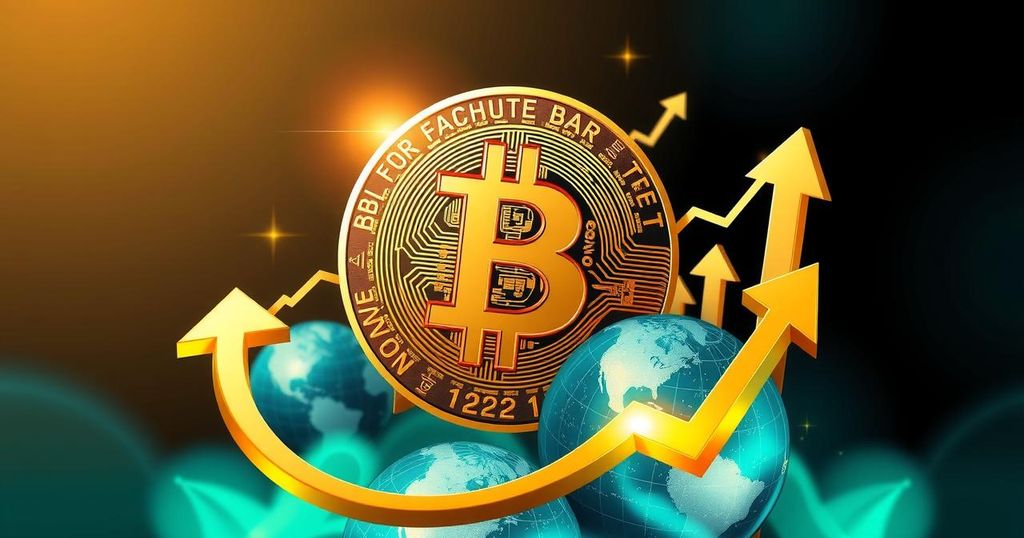Three Key Reasons for Bitcoin’s Recent Surge
Bitcoin’s price surges nearly 40% in six months, driven by reflexivity, evolving government policies, and large-scale investments from major companies known as “whales.” As new policies emerge globally, institutional interest in Bitcoin is growing. However, the volatile nature of the market remains a warning for cautious investors.
Bitcoin’s price has seen a notable rise—nearly 40% over the last six months—and indications suggest this surge may keep going strong. It’s not just a random price bump; analysts pinpoint a few key drivers behind this bullish trend. Here, we delve into three major factors influencing Bitcoin’s upward momentum.
Firstly, we must talk about reflexivity. Some investors tend to believe that asset value solely relies on concrete fundamentals, dismissing the emotional influences of fellow traders. This notion is largely inaccurate, especially for volatile assets such as Bitcoin. Reflexivity describes a robust feedback loop between an asset’s price and its perceived fundamentals—where investor sentiment impacts Bitcoin’s price, and subsequently, price fluctuations can shift investor beliefs. Although this mechanism can yield long-lasting effects when underpinned by solid fundamentals, Bitcoin, lacking traditional valuation drivers, showcases pure reflexivity. Its rise begets further interest, creating a self-reinforcing loop. But caution is advised—this phenomenon can flip, where negative events could rapidly devalue Bitcoin, posing risks to quick speculative buyers.
Next on the agenda is the evolving landscape of government policy regarding cryptocurrencies. It appears we are witnessing a positive shift. Recent announcements, particularly from the Trump administration, suggest the creation of a Strategic Bitcoin Reserve. Although still in conceptual stages with no specific plans for execution, such a move would mark the U.S. as a significant Bitcoin holder, effectively taking supply off the open market. This can undoubtedly impact price as more coins are held indefinitely.
Additionally, several countries like Russia and Japan are exploring similar approaches, raising awareness around Bitcoin allocation. Even if concrete policies are slow to emerge, the growing dialogue signals a shift, prompting investors to consider current Bitcoin purchases appealing. Notably, China’s shifting tone regarding possible regulatory frameworks hints at a more open stance, which investors find encouraging. Hence, institutional interest is rising as governments’ previous efforts to stifle cryptocurrencies fade, opening doors for both big players and individual investors alike.
Finally, let’s talk about Bitcoin whales—those major investors making bold moves. Recently, Bitcoin treasury company Strategy reported a staggering $1.4 billion in purchases within a week, escalating its total holdings to over $52 billion. This size of investment is not just a one-time event, and it isn’t exclusive to this company. Prominent firms, including Tesla, are also adding Bitcoin to their balance sheets, indicating a trend among major corporate players.
The implications of these large purchases are significant. Companies that buy Bitcoin may prefer to keep it and use it as collateral for loans rather than selling. This strategy effectively reduces the available supply for future buyers. The more institutional interest accumulates, the stronger the pressure on Bitcoin prices to rise. Hence, we are witnessing a continuing pattern of growing Bitcoin demand as more whales enter the market, driving prices up even higher than their current levels.
To sum it all up, the robust demand driven by reflexivity, favourable government stances, and significant investment from whales paints a bullish picture for Bitcoin in the foreseeable future. Investors should, however, remain vigilant, as the volatile nature of the cryptocurrency market can shift swiftly.




Post Comment